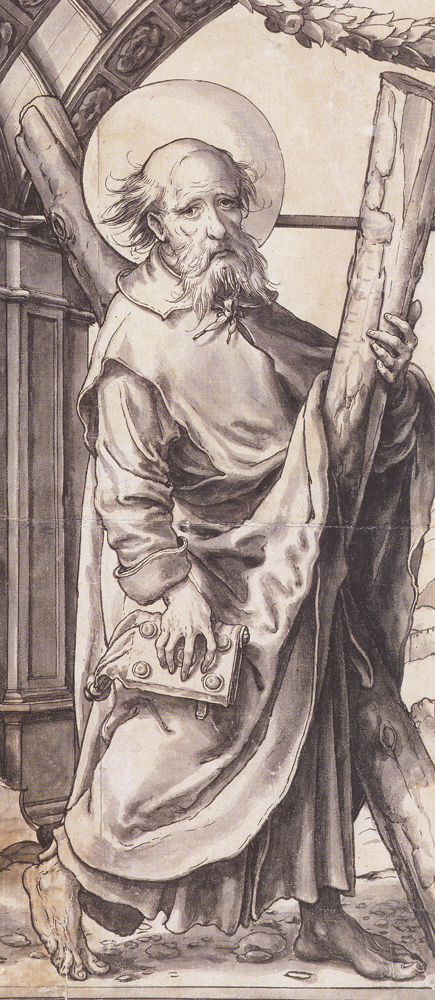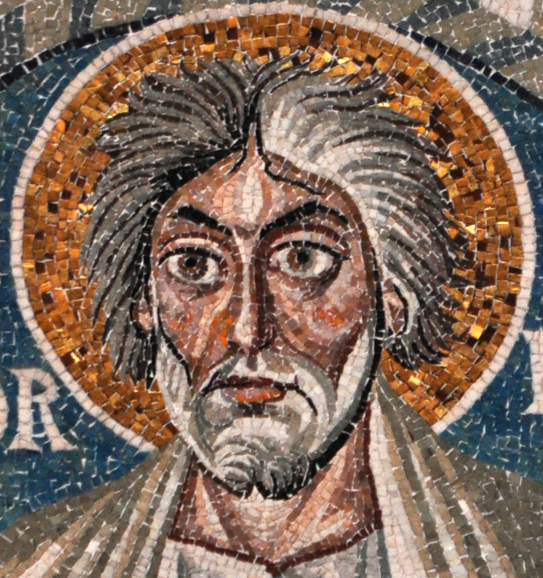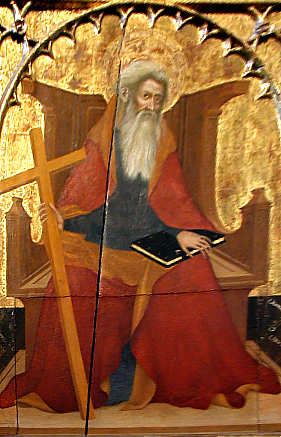Wild hair is an individualizing characteristic of St. Andrew portraits from at least as early as the 6th century (second picture at right) to as late as the fifteenth (third picture at right). In this 13th-century mosaic, where the apostles are labeled, only Paul, Peter, and Andrew are individualized, and that only by the latter's wild hair and the beards on the other two.
In the hagiography, I have not yet found any direct description of the saint's hair, but perhaps there is a connection with his conversation with Christ about the the latter's promise, "a hair of your head shall not perish" (Luke 21:18). In any case, medieval and later artists tend to give the saint a more manageable haircut (example).
As for the beard, most medieval and later images tend to show it as a good deal longer than the Holbein at right, and somewhat less forked (medieval example, 15th-century example, 16th-century example). In early images (such as this mosaic and the second picture at right), the beard is not long at all.
The Cross is important in the Andrew hagiographies. Not only do they have him die on a cross, but they report lengthy disquisitions on his part explaining the mystery of the Cross. These sermons continued even while he was on his own cross when he was crucified in Achaia, to the awed inspiration of the crowd. (See Corona's painting of the event and the mosaic portrait in St. Paul Outside the Walls where the scroll he holds says that he prayed to the Lord while on the cross.)
The portraits sometimes have Andrew with a slender hand cross or processional cross (example), but more often his cross is pictured as large enough to hold a man, as it is in the Holbein at right and in this fresco from Croatia of about the same period in the 16th century. The fresco uses the style of cross seen in older portraits, a simple ✝ like Christ's. The X shape, called the "cross saltire" goes back at least as far as the 15th century (example). It refers to a later tradition that Andrew did not feel worthy to be given a cross like Christ's. The tradition could perhaps be influenced by the story of St. Peter's crucifixion upside-down. In a 15th century Catalan altarpiece the Achaians seem to be crucifying him sideways!
As an apostle St. Andrew is also commonly shown with a book. Just before his death on the cross in the Golden Legend account, he speaks of his yearning for "the purity of contemplation," and a contemplative emphasis may be behind the way he seems to meditate on his book in the Isenbrant Crucifixion and even the monkish garments he wears in some portraits (example).
NARRATIVE IMAGES
Christ calls Andrew and his brother Peter to follow him in Matthew 4:18-20 and Mark 1:16-18, and this is a common subject (example). Less common is his role in the story of the multiplication of the loaves and fishes (example). The legendary episodes of his years as an evangelist and thaumaturge are pictured in this remarkable altarpiece in the Cloisters in New York.
Prepared in 2014 by Richard Stracke, Emeritus Professor of English, Augusta University.
HOME PAGE

Holbein the Younger, St. Andrew, 1519-21 (See description page)

St. Andrew in the triumphal arch at the Basilica of San Vitale, Ravenna (6th century). See the description page.

Detail of the St. Andrew Altarpiece (Catalunya, 1420-30) (See description page)
ATTRIBUTES
- A cross, often full size and sometimes X-shaped.
- Wild hair, long beard
MORE IMAGES
- 12th century: Mosaic of St. Andrew in the Palatine Chapel.
- 13th century (est.): Stained glass window with Andrew and three other Apostles.
- 13th century (est.): The Apostles Window in Regensburg Cathedral, picturing the martyrdom of each Apostle.
- Early 14th century: St. Andrew's portrait is among Aretino's panels of Apostles and saints in Santa Maria Novella, Florence.
- 14th century: This window in Vienna's cathedral labels St. Andrew but dispenses with the traditional attributes.
- 1390s: Andrew stands with a full-size cross on his shoulder among the other saints on the left wing of Cenni di Francesco's Coronation of the Virgin altarpiece.
- 14th-15th century: A fresco tentatively identified as St. Andrew.
- 15th century: A portrait of St. Andrew in a Spanish altarpiece of the Pietà.
- 1513-14: With SS. Jerome and John the Evangelist in the Costabili Polyptych
- Beginning of the 18th century: Jacopo Amigoni's St. Catherine and St. Andrew in San Stae, Venice.
- 1708-1709: Camillo Rusconi's St. Andrew
- Circa 1710: Statue among the other apostles in St. Peter's, Munich.
DATES
- Feast day: November 30
BIOGRAPHY
- Golden Legend #2: html or pdf
- Acts of Andrew
- Acts and Martyrdom of the Holy Apostle Andrew
- The Acts of Andrew and Matthias
- The Acts of Peter and Andrew
- Andrew's vita in The Roman Breviary: English translation, I, 611-12; Latin original, 770-75
- The Anglo-Saxon Andreas, in Krapp, II, 3-51
- pseudo-Abdias, 286-326
- Max Bonnet, three texts on St. Andrew in Analecta Bollandiana, XIII (1894): "Acta Andreae Apostoli cum Ladatione Contexta," 308-52; "Martyrium Sancti Apostoli," 353-72; "Passio Sancti Andreae Apostoli," 373-78.
ALSO SEE